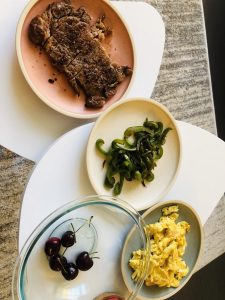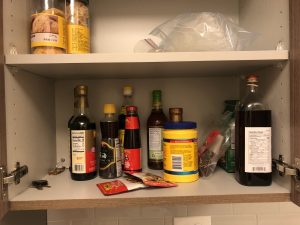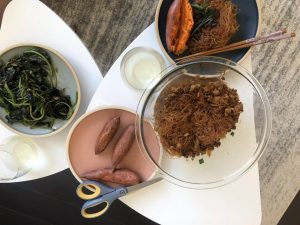I am staying with my friend, Echo Wang, in New York City right now. She is my elementary school’s classmate and we keep our friendship through all these years. We are from the same town, Shanghai. We share similar life experience; we spent our childhood in China, and we studied in United States for our college. The merge of two distinct culture influence our kitchen tables. I want to study how her kitchen table is different from mine and how the cultural significance influences her kitchen table.
Her table will be a good example to study. She just moved into her apartment this week. She needed to prepare her kitchen table from scratch. All her shopping choices for her kitchen, which reflects her cultural identities will be interesting to study. From “Eating Culture- An Anthropological Guide to Food” by Gillian Crowther, “Through making spatial and temporal comparisons and applying cultural relativism”, it “highlights the importance of local responses to global food system and their ability to reinvigorate and maintain distinct cultural identities through food.” (p.23) As Echo is a girl from China and living in USA, she is a good example to examine how her local responses to Western or global food system, and how she reinvigorates and maintain distinct cultural identities through food. I will use the participant observation as my main anthropological method to study. Then I will use the interview method to ask for her own insights and opinions.
According to “Eating Culture”, participant observation method involves helping with food getting, preparing ingredients, cooking, cleaning (p.21). Therefore, I went with Echo every time she went to a grocery store. I helped every dish that she cooks and also helped to clean afterwards. For food getting, we went to typical American style grocery stores 3 times and then we went to a Chinese style grocery store once. All the food from the American style grocery lasted for 4 days and then we went to the Chinese grocery store. For typical American style grocery stores, she picked chicken breasts and steak for meat; spinach, celery, tomatoes, green pepper and French green beans for vegetable; oat milk, eggs and butter for dairy products; figs, strawberries and cherries for fruits. The food that prepared from these ingredients are mostly Western style dishes: salt and pepper on the beef steak, salt and pepper on the pan-fried chicken breast, scrambled eggs, raw celery. Two dishes that were in Chinese style dish are garlic flavored French beans or sliced green pepper and fried tomatoes with scrambled eggs. The ingredients that she chose were abundant and basic in Western or global food systems. Her cooking style of all these ingredients were in Western style. The only difference was in the cooking of vegetables. Chinese people do process almost all veggies in frying pans. She put some oil and fried the sliced garlic first and then put the French green beans and sliced green pepper in. She did not choose the way that Americans usually cook – steam or boil the vegetable and then put some seasoning or butter on it.

After several days without any Chinese style seasoning and ingredients, Echo and I went to a Chinese grocery store. She went straight to the seasoning aisle and noodle aisle. She took all the seasonings that almost every Shanghainese family have: two different types of soy sauces, vinegar from Zhejiang Province, sesame oil, red spicy oil and corn starch. She also spent a lot on the meat section, especially for pork, beef shank and chicken hearts. These are the rare ingredients in other grocery stores. She also shopped in the frozen food section, got some Chinese style buns, dumplings and prepared Gyudon (Japanese style beef on the rice). After the shopping, she prepared the dinner with variable Chinese dishes. However, I noticed the western style dish is still on her kitchen table: the way of cooking the meat. Chinese style of cooking the chicken is usually pan-fried. However, she chose to boil the chicken breast. She did not use the Chinese seasoning for the chicken. Then, she cooked noodles for the main dish.

To summarize the findings which I observed from her kitchen table, I recognized that she was influenced by Western style cuisine. She always cooked the meat with salt and pepper; she enjoys eating raw vegetables. Even with Chinese seasoning, she will not choose to flavor the meat with it. However, she also cannot live without any Chinese dishes in her cooking. There must be one Chinese dish on the table. It can be noodle or the way of cooking the vegetables. After cooking, we all washed the dishes. She uses the Chinese way of cleaning the dishes – no dishwasher, but hand wash. She uses the Chinese dish cloth, which her parents brought from Shanghai to her, to clean the dishes. The biggest difference from my family is that she does not use any dish detergent, but only the hot water to rinse.

After all the observation, I conducted a short interview with her. I mentioned about the way of western style meat cooking on her kitchen table, she commented that she learned from her US friends that this is a healthier way. She believes that less oil, less seasoning in the diet is a healthier way of cooking protein. She also really enjoys eating raw vegetable after she came to US. She mentioned that there were not much of vegetable choices on campus for her; the most abundant ones are salads. She was not used to it at first, as she wanted cooked vegetables in Chinese style. She was surprised how she mixed Chinese and Western style of cooking in her dishes, when I told her how my family usually cook the similar dish in Shanghai. Echo also pointed out a very interesting point: she studied in Britain for a year. She put oat milk in her black tea now, while Chinese people will not add anything in the tea. The mixture of the culture influences every bit of her kitchen table now.
Echo and I have similar culture background. We both enjoyed a lot of her cooking – the mixture of Western style and Chinese style. The local food sources influenced us to cook for Western style cuisines, but we still eager Chinese style cuisine. The mixture of two culture significances hugely make up Echo’s kitchen table. I believe, it is the unique style of food cooking among Chinese students who study abroad in Western countries.
Works Cited:
Crowther, Gillian. Eating Culture: An Anthropological Guide to Food.University of Toronto Press, 2013.

Jenny, effective opening and nice reference to Crowther. Your approach to the “kitchen table” is more metaphoric than the prompt asks for. The few questions the prompt raises–why this particular table, what you observed, and what conclusions and practices concerning–are meant for you to observe the table itself more closely and directly. I’ve come to accept your particular approach because you did a really good job on discussing the cultural significance surround your friend Echo’s table. More carefully reading the prompt next time. Stylistically, a few problematic choices (for instance, the sentence after the Crowther quote in para#2).